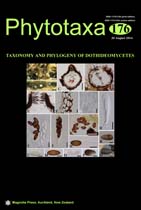Abstract
A new species Homortomyces tamaricis is introduced from Cervia, Italy. It is distinct from H. combreti, the type species of this monotypic genus, in having smaller conidia, smaller paraphyses and shorter supporting cells. Morphologically Homortomyces is similar to Stilbospora, which groups in Diaporthales incertae sedis in maximum-likelihood analysis of LSU rDNA sequences. Maximum-likelihood analysis of the combined data set of LSU and ITS rDNA sequences indicates that Homortomyces species cluster with Tubeufiaceae with 77% bootstrap support, but group as a distinct clade with high bootstrap value (100%). These two genera show convergent evolution since both share very similar morphological characters, but have distinct phylogenetic lineages. Further phylogenetic analyses are needed, when more strains of Homortomyces and related genera are available, to resolve the genus familial placement. We maintain the genus in Dothideomycetes incertae sedis. No sexual state has yet been reported for this genus.

